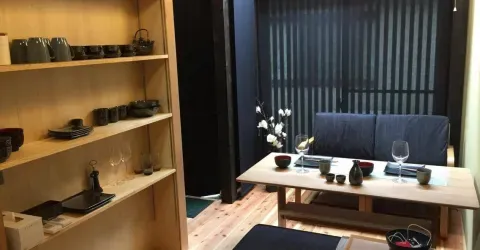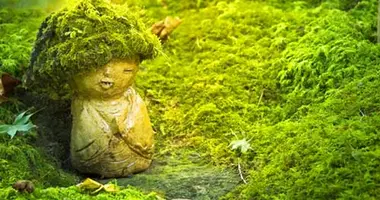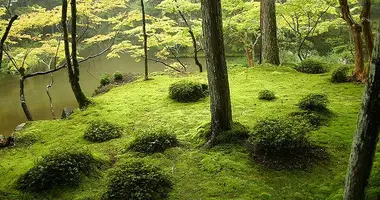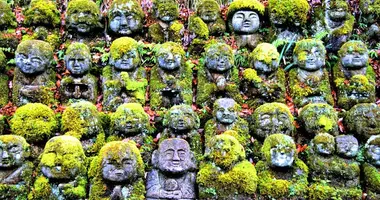The Ryôzen Kannon, a giant statue in Kyoto 霊山観音
A war memorial for the dead of the Pacific War
With regard to the emblematic sites and monuments of the historic district of Higashiyama, literally "the mountain of the east", the Ryôzen Kannon temple is an outsider in the classic tourist itineraries. However, this place reveals many surprises to its visitors; starting with its memorial dedicated to the soldiers who died during the Second World War.
An Off-the-Beaten-Path Tour in Kyoto
After a visit to the famous Kiyomizu-dera , tourists often stroll through the narrow streets of Sannenzaka and Ninenzaka to soak up the traditional atmosphere of the Higashiyama district on their way to another must-see monument, Kodai-ji temple .
But before heading towards the latter, leaving Ninnenzaka street, we kindly ask you to raise your eyes to your right towards the heights of the district. From the green hills, Kannon, the Goddess of Mercy gazes down at you and smiles benevolently. Although measuring 24 meters in height, this immaculate white sculpture of the deity, symbol of the Ryôzen Kannon , still goes far too often unnoticed by tourists. Seeing it will certainly pique your curiosity and make you deviate from your well-trodden tour route.
Promote peace and honor the memory of fallen soldiers.
Inaugurated in June 1955, the Ryôzen Kannon is the embodiment of the hope for peace of one man: Hirosuke Ishikawa .
At the end of the Second World War, this businessman and leader of the Teisan group, an automobile transport company (bus and taxi) created in 1946, wanted to promote peace and honor the memory of fallen soldiers .
To do this, he founded the Ryôzen Kannon, a Buddhist temple ensuring the rest of the souls of the fighters, just ten years after the end of the conflict.
Within the precincts of the temple, a chapel, adorned with stained glass serves as a memorial to the two million Japanese and foreign soldiers who died during the fighting in the Pacific zone . A memorial service is held there four times a day.
This monument dedicated to peace, far from being a nationalist monument , pays particular homage to Allied soldiers and prisoners of war who died in combat under the control of the Japanese army during the conflict. The names and files of all these soldiers are kept in the drawers of a large library located in the chapel. An altar also preserves earth from each of the military cemeteries in the Pacific as evidence of the too many lives needlessly lost.
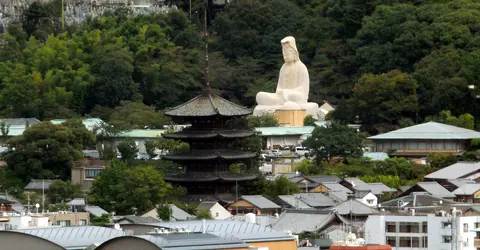
The goddess Kannon watches over the Higashiyama district
Brücke-Osteuropa
Kannon, the goddess of compassion
Hirosuke Ishikawa made the choice to place the temple under the protection of Kannon , a boddhisattva (being who has reached the state of enlightenment but who has chosen to suspend his status as a Buddha) embodying compassion.
It is also a gigantic statue of the latter which dominates the entire site and is reflected in the central basin. Made of reinforced concrete, it is the work of Yamazaki Choûn (1867-1954) , one of the greatest Japanese sculptors of the early 20th century.
Posted on the central building of the temple, it is 24 meters high and weighs nearly 500 tons . Despite its imposing dimensions, the Buddhist goddess inspires only benevolence and peace of mind in visitors.
By passing to the left of the main hall and taking a staircase at the back of the sculpture, you can enter inside it . There are enshrined the twelve guardian statues of the goddess; each being associated with a sign of the zodiac. Choose to make your prayer in front of the one that corresponds to your date of birth.
The Nousashou-Nyoi-Houju Buddhist Treasure
In these particularly pleasant places during the cherry blossom season, another treasure awaits you. And we are indeed talking here about a treasure in the proper sense: the hidden treasure of esoteric Buddhism called Nousashou-Nyoi-Houju . This sacred gem would be able to remove suffering and allow everyone to fulfill all their desires.
This treasure from the Nyoi-Houju, the cosmic energy that breathes life into all living beings, comes in a spherical shape .
Two theories dispute the origin of this jewel: it would have emerged from the head of Ryuuou, the dragon king or would have been made from eleven precious materials including the ashes of Buddha, gold, silver and various species of wood.
It would have been hidden during the Heian period (794 - 1185) in a sacred place. A place that today corresponds to the location of the Ryôzen Kannon!
Don't miss the opportunity to pray the orb of wishes during your visit. If you go around this large golden sphere and then put your hand on it while making your wish, your wish will be granted! A sphere of wishes that will undoubtedly convince you to add the Ryôzen Kannon to your day of visit!
Address, timetable & access
Address
Phone
+81 75-561-2205Timetable
From Kyoto Station, take bus No. 206 or No. 207. The temple is a 5-minute walk from the Higashiyama-yasui stop.Price
Adult: 300 yen. High school student: 200 yen. Child: 100 yen.Access
Open daily from 8:40 a.m. to 4:20 p.m.Website
http://www.ryozen-kwannon.jp/indexE.html













